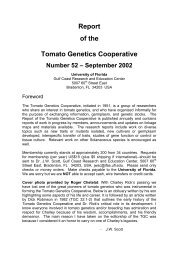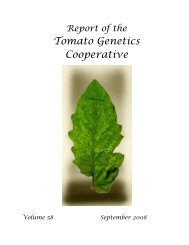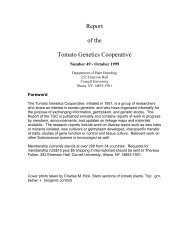Volume 60 - Tomato Genetics Cooperative - University of Florida
Volume 60 - Tomato Genetics Cooperative - University of Florida
Volume 60 - Tomato Genetics Cooperative - University of Florida
Create successful ePaper yourself
Turn your PDF publications into a flip-book with our unique Google optimized e-Paper software.
Research Papers TGC REPORT VOLUME <strong>60</strong>, 2010<br />
Study <strong>of</strong> epidermal cell size <strong>of</strong> petals and stamens in tomato species and hybrids<br />
using confocal laser-scanning microscopy<br />
Christopher L<strong>of</strong>ty, Julian Smith, Pravda Stoeva-Popova<br />
Department <strong>of</strong> Biology, Winthrop <strong>University</strong>, Rock Hill SC 29733<br />
E-mail: stoevap@winthrop.edu<br />
Introduction<br />
The phenomenon <strong>of</strong> cytoplasmic male sterility (CMS) has been described and<br />
the genetics underlying the phenomemon studied in many species. Whether arising<br />
spontaneously, as the result <strong>of</strong> mutations, or through alloplasmic incompatibilities in<br />
interspecific crosses, the main effect <strong>of</strong> CMS is on the development <strong>of</strong> stamens and<br />
pollen, leading to aberrant stamens with no pollen or aborted pollen (Kaul 1988). Other<br />
changes correlated with the CMS phenotype are changes in the second whorl affecting<br />
petal size and color (Andersen 1963, 1964; Petrova et al. 1999; Farbos et al. 2001;<br />
Leino et al. 2003)<br />
In the tomato, CMS does not occur naturally. CMS has been reported in<br />
interspecies hybrids. Andersen (1963, 1964) reported the emergence and increase <strong>of</strong><br />
pollen abortion in F1 and backcrosses <strong>of</strong> the crosses between Solanum lycopersicum,<br />
S. cheesmaniiae (formerly L. chesmanii f. typicum and f. minor) or S. habrochaites<br />
(formerly L. hirsutum f. glabratum) used as pistillate parents and S. pennellii as the<br />
recurrent pollinating parent. Pleiotropic effects <strong>of</strong> the CMS phenotype included the<br />
reduction <strong>of</strong> anther length and size, and the lengthening <strong>of</strong> the filaments. The anther<br />
size was negatively correlated to the percent <strong>of</strong> aborted pollen.<br />
Similar results were observed by Valkova-Atchkova (1980) in crosses involving<br />
S. peruvianum as pistillate parent and S. pennellii and S. habrochaites (formerly L.<br />
hirsutum f. typicum) as pollinating parents. Further introgression <strong>of</strong> the nuclear genome<br />
<strong>of</strong> the recurrent parents confirmed the stability <strong>of</strong> the CMS phenotype over many<br />
generations (Petrova et al. 1999, Stoeva et al. 2007).<br />
As a preliminary step to dissecting morphological (and underlying genetic)<br />
changes occurring in the CMS phenotype, this study has focused on the comparative<br />
analysis <strong>of</strong> the size <strong>of</strong> epidermal cells from abaxial and adaxial sides <strong>of</strong> petals and<br />
stamens <strong>of</strong> mature flowers from CMS-pennellii line (0% stainable pollen), the isonuclear<br />
S. pennellii (100% pollen fertility), and the cultivated tomato S. lycopersicum.<br />
Materials and methods<br />
Plant material<br />
In the study the following genotypes were used: Solanum lycopersicum (cv.<br />
Merkurii), Solanum pennellii (LA716), and CMS-pennellii (CMS line) previously<br />
described in Petrova et al. (1998) and Radkova (2002). To determine the size <strong>of</strong> the<br />
epidermal cells, fully expanded flowers in stage 20 according to the classification <strong>of</strong><br />
Burkhin et al. (2003) were collected from plants grown in the same environmental<br />
58





